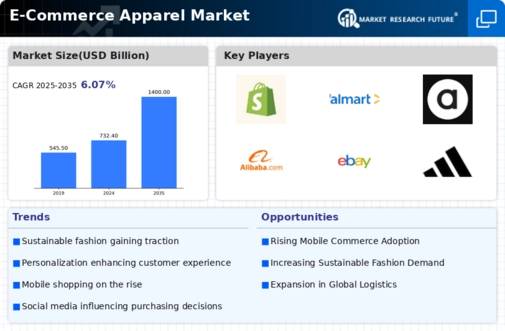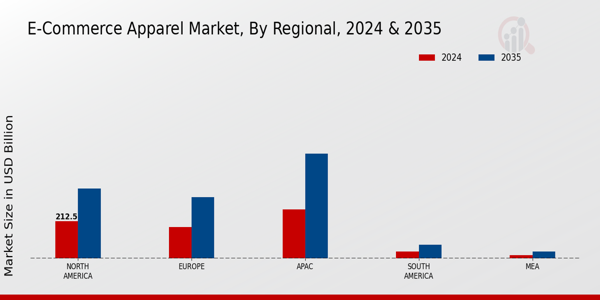Market Growth Projections
The Global E-Commerce Apparel Market Industry is poised for substantial growth, with projections indicating a market value of 732.4 USD Billion in 2024 and an anticipated increase to 1400 USD Billion by 2035. This growth trajectory suggests a compound annual growth rate of 6.07% from 2025 to 2035, reflecting the increasing consumer shift towards online apparel shopping. The market's expansion is likely to be fueled by various factors, including technological advancements, changing consumer preferences, and the ongoing optimization of supply chains. These projections underscore the dynamic nature of the e-commerce apparel landscape.
Diverse Consumer Demographics
The Global E-Commerce Apparel Market Industry is characterized by diverse consumer demographics, which influence purchasing behaviors and preferences. As the global population becomes more interconnected, retailers must cater to a wide range of cultural and regional tastes. This diversity presents both challenges and opportunities for brands aiming to expand their market reach. By understanding and addressing the unique needs of various demographic segments, companies can tailor their marketing strategies and product offerings. This adaptability is crucial for sustaining growth in a competitive landscape, particularly as the market continues to evolve.
Rising Online Shopping Trends
The Global E-Commerce Apparel Market Industry experiences a notable surge in online shopping trends, driven by the increasing preference for convenience and accessibility. Consumers are increasingly opting for online platforms to purchase apparel, leading to a projected market value of 732.4 USD Billion in 2024. This shift is further supported by advancements in technology, which enhance the online shopping experience through personalized recommendations and user-friendly interfaces. As consumers become more accustomed to digital transactions, the market is expected to expand significantly, indicating a robust growth trajectory in the coming years.
Global Supply Chain Optimization
The optimization of global supply chains significantly influences the Global E-Commerce Apparel Market Industry. Efficient logistics and inventory management systems enable retailers to respond swiftly to consumer demands, ensuring timely delivery of products. This efficiency is crucial in maintaining customer satisfaction and loyalty. As companies invest in supply chain technologies, they can reduce operational costs and improve profitability. The ongoing enhancements in logistics are expected to support the market's growth, contributing to a compound annual growth rate of 6.07% from 2025 to 2035, reflecting the increasing importance of streamlined operations in e-commerce.
Sustainability and Ethical Fashion
Sustainability has emerged as a key driver in the Global E-Commerce Apparel Market Industry, with consumers increasingly prioritizing eco-friendly and ethically produced apparel. Brands that adopt sustainable practices are likely to attract a growing segment of environmentally conscious consumers. This trend is reflected in the rising demand for organic materials and transparent supply chains. As sustainability becomes a focal point for consumers, companies that align their offerings with these values may experience enhanced brand loyalty and market share. This shift towards ethical fashion is expected to play a significant role in shaping the future landscape of the apparel market.
Technological Advancements in Retail
Technological innovations play a pivotal role in shaping the Global E-Commerce Apparel Market Industry. The integration of artificial intelligence, augmented reality, and virtual fitting rooms enhances the online shopping experience, allowing consumers to visualize products before purchase. These advancements not only improve customer satisfaction but also reduce return rates, which is a critical concern in the apparel sector. As retailers adopt these technologies, they are likely to attract a broader customer base, thereby contributing to the projected growth of the market, which is anticipated to reach 1400 USD Billion by 2035.
























